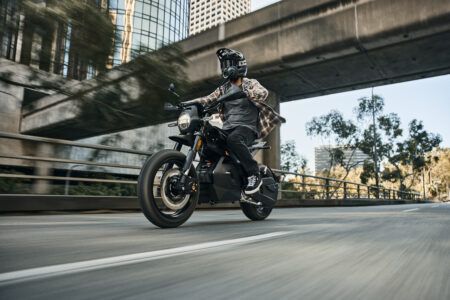With any vehicle, keeping weight down is key to efficiency. But for EVs it’s becoming increasingly important that all components – from chassis to wheels to casings – are as lightweight as possible. Here we speak to OEMs who are watching their weight.
As vehicles get heavier with the introduction of larger models and battery-electric powertrains, lightweighting technology is becoming increasingly important. For passenger cars, lower weight results in better fuel economy and energy efficiency. In commercial vehicles reducing weight maximizes payload capabilities which is an essential part of fleet and business operations. Aside from vehicles growing to accommodate more passengers or larger storage compartments there are a couple of other heavy culprits. An increase in safety features required for regulatory purposes add extra weight. Combined with advanced infotainment systems and sensors to facilitate some levels of autonomous driving, weighty technology is only set to increase as we edge closer to fully autonomous vehicles.
By far the heaviest addition is batteries. To offer equivalent range to petrol and diesel cars, vehicles are equipped with large battery packs. “Bigger means heavier and all the parts around the powertrain need to be bigger and heavier to carry that increased load,” says Andrew Halonen, President of Mayflower Consulting, LLC, a lightweighting consultancy firm. Steel is commonly used in automotive manufacturing given its cheap price, availability, and strength, but compared to other metals it’s heavy. Some manufacturers such as JLR have transitioned to using aluminum components which are lighter but to achieve the same strength characteristics aluminum parts often need to be thicker. Professor Alan Banks, Innovation and Industrial Engagement Supervisor at Ford explains, “Steel has developed hugely in the last five to ten years. Advanced high-strength steel and dual phase steel have come to market so we can reduce the thickness of the material but still get the mechanical properties we need.” New innovations in metal production and fabrication can make a small difference to vehicle weight but to dramatically reduce weight, composite materials could be the answer.
 Blended approach
Blended approach
As the Chair of the Board of Directors for Composites UK, Banks says, “There is not going to be a net zero economy without composite material.” But to get to that stage there’s a few challenges to overcome. Firstly, composite materials with the desired properties for automotive manufacturing are currently very expensive. As a volume manufacturer, Banks explains, “We need to be confident that when we give a new material or a new vehicle to our customers it’s what they want, what they can afford, and runs with their cost of ownership model.” An expensive material can also result in costly development but with sophisticated computer modeling, manufacturers are able to experiment with different materials without needing to build real prototypes.
“Simulators play a critical role in trying to enable these new composites trials,” says Executive Director at Ansible Motion, Salman Safdar. Virtual testing allows engineers to experiment with new materials in a quick and cost-effective way. This also facilitates unlimited crash testing which would otherwise be extremely expensive.
To achieve a simulator environment that can accurately capture the effects of different materials programmed into the system, the simulator itself needs to employ lightweighting technology. Safdar explains, “The lighter the cabin, the more dynamic. Latency is typically low if you’ve got less mass to move around.” This is important so testers within the simulator don’t perceive a delay that is caused by the weight of the cabin. Instead, the company works to achieve latencies below 15 milliseconds, anything above this is said to be noticeable. “We try to achieve around 8 milliseconds, which is practically half of what a human can recognize,” says Safdar. When moving with six degrees of freedom the simulator must also be incredibly robust, so Ansible Motion uses composites to strike the right balance of material stiffness and lightness.
Environmental elements
Whether these composites are being sourced for simulators or real vehicles, no two materials are the same. “One supplier is completely different to another, they’ve got different mechanical properties,” says Banks. Unlike metals which will fundamentally be the same from different producers, each composite supplier has their own unique formula. In an automotive context, composites are created using different types and lengths of fibers mixed with resin. This leads to disparities between suppliers based on the fibers and resins they use.
And if an automotive manufacturer chooses a composite material, it can only be supplied by the same supplier. “What if that supplier’s plant burns down? Where else are you going to get that part from? Nobody else makes it,” says Halonen. There is inherent risk in this strategy as the supplier must be able to keep up with demand, produce the material consistently in the same way and not be subject to any manufacturing delays.
The variability of composites also presents an environmental challenge. It is difficult to establish the embodied carbon emissions of a composite as again, this differs from supplier to supplier. Regardless of the emissions emitted in the creation of these composites, the materials also need to be recyclable after use. Existing recycling methods use heat in pyrolysis or chemicals in solvolysis to separate the resin and fibers.
“The fibers are mechanically damaged in these processes, so the material is effectively downcycled,” says Banks.
B&M Longworth has developed a method called Deecom pressolysis which uses heat and pressure to separate resin and fibers without degrading the material in the process. Banks says, “We believe this is a 100 percent circular process whereby you can recover every element that went into the fiber in the first place. You can reuse them into other things, but the fiber – which is the valuable part – can be used as a fiber again and that’s going to be game changing.”
Establishing a robust circular supply chain will be essential in adopting any new materials. As electric vehicles are replacing polluting fossil-fuel-powered transport manufacturers have a responsibility not to create a more polluting product instead. Even when composites with the right mechanical properties for automotive applications become more affordable, manufacturers will likely adopt mixed material approaches. This will allow some components to be made from lighter materials such as aluminum and others from steel.
Longer lighter life
Until then, Halonen proposes a lightweighting solution that is addressed outside of the vehicle manufacturing process. “If charging infrastructure was everywhere like gas stations then you don’t need big batteries and vehicle weight can be reduced.” Compared to petrol and diesel, the batteries currently used in automotive have poor energy density. Improving the battery’s ability to provide more range without suffering weight penalties or reducing the requirement for long range will make the largest impact on overall vehicle weight.
From a consumer perspective, Halonen argues the power to weight ratio of electric vehicles can help to disguise some of the negative performance characteristics typically associated with heavier cars. “I think a lot of people perceive that EVs are a stronger candidate for lightweighting. Yet, in today’s reality of EV costs, affordability is such a huge hurdle,” Halonen comments. This underlines the importance of cost-effective material development that doesn’t contribute to increasing EV prices.
In an ideal world, successful lightweighting implementation will extend vehicle life. “As we start to use more aluminum and composite materials there’s no reason why a vehicle that would traditionally last 15 to 20 years wouldn’t last 30 to 35 years,” says Banks. Reducing weight results in less wear and tear on the drivetrain and using materials that don’t rust improves longevity.
There’s rarely ever a one size fits all solution in something as complex as vehicle manufacturing. The technology to minimize vehicle weight exists but until it’s available at the right price with trackable emissions data over a material’s life cycle we might still be a few decades away from mass produced carbon fiber EVs.
 Trailer lightweighting
Trailer lightweighting
In the commercial vehicle sector, lightweighting solutions extend beyond the truck itself to trailers and bodies. Armory Technologies has created a new trailer panel using what it calls origami composites. “We have the ability to embed a geometry into a 2D shape to increase its physical, mechanical properties: its stiffness and strength,” explains Dan McGivney, Vice President of Sales at Armory Technologies.
The panels are created by thermoforming plastics such as polypropylene, APET and ABS. The formed panel is then laminated with a steel or composite skin to complete the product. The idea behind this trailer panel reinvention is to create a solution that overcomes the limitations of honeycomb. “The difference between honeycomb and the origami composites is honeycomb has good strength in one direction and the origami composite is an auxetic material, so it has good multi-directional strength,” says McGivney.
As well as having advantageous strength characteristics, its light form can significantly reduce the weight of a trailer. Amory Technologies claims its trailer panels are up to 59 percent lighter than traditional trailer siding. This can reduce the weight of a trailer by anywhere from 1000 to 2000lbs (454 to 907kg).
Based on the number of trailers operating in a fleet, average annual mileage, average fuel prices and average fuel efficiency, Amory Technologies can calculate potential fuel cost, weight, and emissions savings. “Our goal is to offer this to market at a cost neutral price to what currently exists,” says McGivney.
To keep the product affordable, the company outsources its thermoforming process to specialists. The American firm has chosen to work with suppliers in the Midwest region to reduce transport emissions and fees associated with moving these materials to trailer manufacturers. Instead, Amory technologies has localized production close to several of the major US trailer manufacturers.
 Adhesive solutions
Adhesive solutions
To achieve a successful mixed material approach, we need new ways to connect materials beyond traditional welding and mechanical fixtures. Sunstar Engineering creates adhesives to solve this. The company’s approach to lightweighting is twofold. “There’s a variety of ways to make adhesives and sealants lighter which usually involves putting some sort of void into the materials to encapsulate air,” explains Nicholas Huff, Manager, New Technology Group, Sunstar Engineering Americas.
However, adhesives are predominantly used to facilitate lightweighting solutions. As well as bonding materials that can’t be welded together, adhesives offer other beneficial characteristics such as improving noise, vibration, and harshness. “Part of the challenge is to develop a system which either dissipates vibrations or increases the damping characteristic of the materials,” says Stephen Howe, Senior Director, Technical Operations, R&D, Sunstar Engineering Americas. “And/or something that moves the vibrations to a different area which isn’t as noticeable.”
This is particularly important with EVs as noise created by the car is more obvious than in vehicles that have engines to disguise these sounds. Howe also notes, “you can balance out the difference in thermal expansion coefficients between two materials.” Bonding two materials that have different thermal properties can cause stress on the joint, so adhesives are designed to account for this.
The argument for lightweighting is often founded in sustainability initiatives too so Sunstar is working to minimize the impact of its adhesives in the manufacturing process. “What we’re seeing come into the marketplace now are adhesives that can cure at lower temperatures with less energy requirements,” says Huff. By eliminating the need to thermally cure an adhesive or producing an adhesive that requires lower temperatures to cure this significantly reduces the amount of electricity consumed during manufacturing.
As EVs tend to have more embedded carbon than equivalent ICE vehicles, finding ways to reduce energy usage in production is a key contributor to reducing the overall environmental impact of a vehicle.





